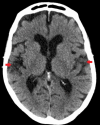Ave Maria and Visions of Children: Atypical Charles Bonnet Syndrome or Two Coexisting Deafferentation Phenomena?
- PMID: 30402359
- PMCID: PMC6200443
- DOI: 10.7759/cureus.3191
Ave Maria and Visions of Children: Atypical Charles Bonnet Syndrome or Two Coexisting Deafferentation Phenomena?
Abstract
Charles Bonnet syndrome (CBS) refers to the experience of visual hallucinations in the context of visual impairment. The underlying pathology may be localized anywhere along the visual pathway from the eye itself to visual cortical centers. It is sometimes compared to phantom limb syndrome; both involve decreased sensory input, as in loss of a limb or declining vision, resulting in overactivity in areas of the brain controlling sensory perception. Definitive diagnostic criteria are still lacking and may vary by discipline. However, the following features are generally agreed upon: visual hallucinations, impaired vision, and intact cognition and insight. Psychiatric symptoms, cognitive decline, and hallucinations of other sensory modalities are often excluded, although this remains an area of debate. Certain non-classic cases of CBS have inspired the designation of atypical CBS, which encompasses a wide spectrum of sensory experiences and associated symptoms. Auditory hallucinations in the hearing-impaired, a well-described phenomenon thought to have a similar pathogenesis, share with CBS the important risk factor of increased age. In patients experiencing both types of hallucinations with deterioration in both sensory domains, the distinction between a CBS variant and two independent processes may not be straightforward. In addition to the ongoing diagnostic dilemma posed by multimodal hallucinations, these phenomena tend to be underreported by patients likely due to concern that they will be diagnosed with mental illness. Although many patients with this condition are indifferent to it, some suffer distress from their hallucinations and would benefit from recognition, reassurance, and in some cases correction of the underlying cause or pharmacologic treatment. Here we present the case of an elderly woman with a history of macular degeneration and chronic hearing loss who experienced complex auditory and visual hallucinations surrounding an episode of severe anxiety. We postulate that her anxiety acted as a precipitant to her hallucinatory experiences and may partially explain their abrupt onset in the absence of other clear pathologic processes. This case serves to reinforce CBS as a possible etiology of visual hallucinations in the elderly population, while also generating discussion of how to classify her particular set of symptoms.
Keywords: atypical charles bonnet syndrome; charles bonnet syndrome; macular degeneration; musical hallucinations; visual hallucinations; visual impairment.
Conflict of interest statement
The authors have declared that no competing interests exist.
Figures
Similar articles
-
A Case Report and Review: Charles Bonnet Syndrome Plus With Dementia.HCA Healthc J Med. 2022 Feb 26;3(1):23-28. doi: 10.36518/2689-0216.1303. eCollection 2022. HCA Healthc J Med. 2022. PMID: 37426870 Free PMC article.
-
[Psychiatric, psychological comorbidities of typical and atypical Charles-Bonnet syndrome].Encephale. 2011 Dec;37(6):473-80. doi: 10.1016/j.encep.2011.05.006. Epub 2011 Jul 7. Encephale. 2011. PMID: 22137220 Review. French.
-
What associates Charles Bonnet syndrome with age-related macular degeneration?Coll Antropol. 2010 Apr;34 Suppl 2:45-8. Coll Antropol. 2010. PMID: 21305724
-
[Complex visual hallucinations in the visually impaired, the Charles Bonnet syndrome].Lakartidningen. 2019 Jan 21;116:FE7L. Lakartidningen. 2019. PMID: 30667516 Review. Swedish.
-
Hallucinatory experiences in visually impaired individuals: Charles Bonnet syndrome - implications for research and clinical practice.Psychiatr Danub. 2018 Jun;30(2):122-128. doi: 10.24869/psyd.2018.122. Psychiatr Danub. 2018. PMID: 29930220 Review.
Cited by
-
A Case Report and Review: Charles Bonnet Syndrome Plus With Dementia.HCA Healthc J Med. 2022 Feb 26;3(1):23-28. doi: 10.36518/2689-0216.1303. eCollection 2022. HCA Healthc J Med. 2022. PMID: 37426870 Free PMC article.
References
-
- Hallucinatory experiences in visually impaired individuals: Charles Bonnet syndrome - implications for research and clinical practice. Jurisic D, Sesar I, Cavar I, Sesar A, Zivkovic M, Curkovic M. Psychiatr Danub. 2018;30:122–128. - PubMed
-
- Visual loss and visual hallucinations in patients with age-related macular degeneration (Charles Bonnet syndrome) Abbot EJ, Connor GB, Artes PH, Abadi RV. Invest Ophthalmol Vis Sci. 2007;48:1416–1423. - PubMed
-
- Charles Bonnet syndrome in age-related macular degeneration: the nature and frequency of images in subjects with end-stage disease. Khan JC, Shahid H, Thurlby DA, Yates JRW, Moore AT. Ophthalmic Epidemiol. 2008;15:202–208. - PubMed
-
- Visual hallucinations in psychologically normal people: Charles Bonnet’s syndrome. Teunisse RJ, Zitman FG, Cruysberg JR, Hoefnagels WH, Verbeek AL. Lancet. 1996;347:794–797. - PubMed
-
- Charles Bonnet syndrome: a review of the literature. O' Farrell L, Lewis S, McKenzie A, Jones L. https://pdfs.semanticscholar.org/6242/0023fc15529fef9a5dea13c0ba78f05ff8... J Vis Impair Blind. 2010;104:261–274.
Publication types
LinkOut - more resources
Full Text Sources

